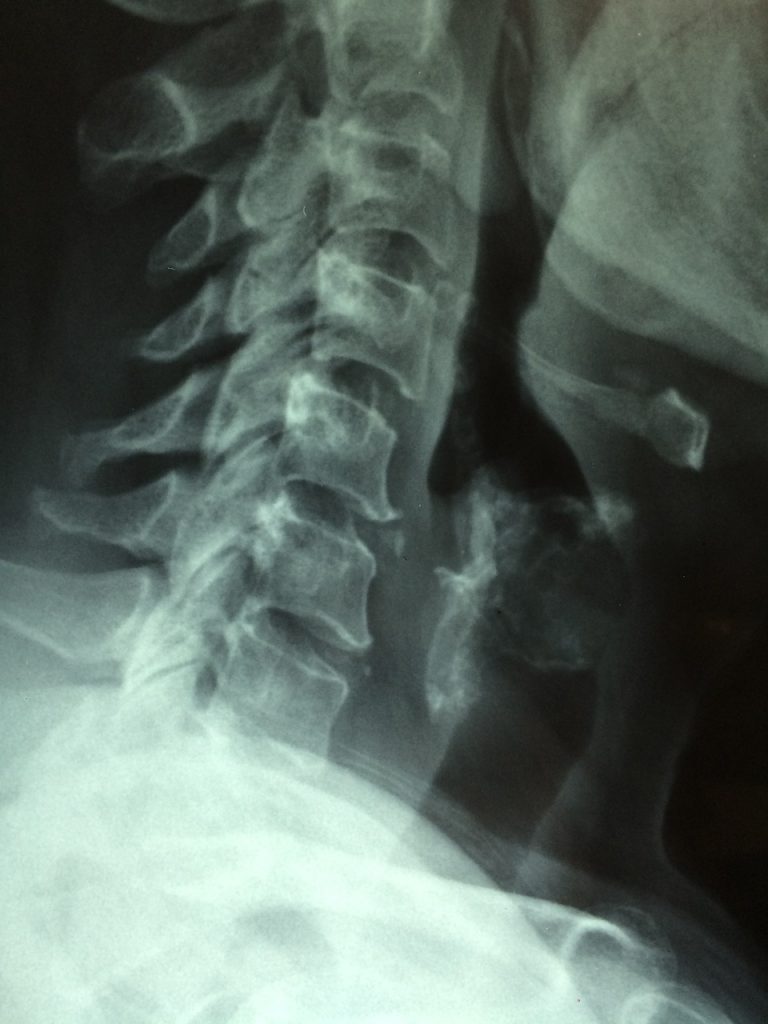A cervical/lumber compression fracture occurs when the bones in the lower spine break due to trauma. This can also be referred to as a vertebral compression fracture. Typically, these types of fractures take extreme force but not always.

Elderly persons and those with cancer can have this type of fracture from accidents with much less impact. 150,000 people each year in the U.S. have a spinal fracture, resulting in an estimated 12,000 spinal cord injuries and approximately 6,000 deaths.
Symptoms Of Lumber Compression Fracture
If there has been a fracture to the spinal bones, there are several symptoms that can be present. Depending on the severity of the break and whether the bones are displaced and putting pressure on the spinal cord itself, the symptoms can include:
- Pain. The pain is usually in the lower back, however it can also sometimes be felt in the upper back, neck, hips, thighs and even the abdominal region. Standing and walking generally hurt worse, while lying down may make the pain dissipate.
- Numbness or weakness. If the nerves around the injury are affected, there can be numbness, tingling or weakness in the back or legs.
- Urination or bowel issues. The fracture can put pressure on the spinal cord and impair the person’s ability to urinate or perform bowel movements.
- Paralysis. If the fracture impacts the spinal cord, there can be partial and sometimes, permanent paralysis.
Diagnosing a compression fracture in the spine
When a cervical/lumbar fracture occurs from trauma, the pain will usually start immediately after the incident that causes it. Medical attention is needed to diagnose the fracture and to begin treatment. A physician will want to perform a scan of the spine to determine the damage.
- X-Rays. The first step will most likely be an X-ray to determine if and where the fracture occurred.
- CT Scan. A CT or CAT scan is often used once X-rays have shown a fracture to determine how stable the fracture is. These can show more details of the fracture and give a different view.
- MRI. If nerve, spinal cord or surrounding tissue damage is suspected, an MRI may be needed. An MRI can look at the soft tissue around the spine and show any abnormalities.
Causes Compression Fractures to the Lumbar and Cervical Spine
Degenerative diseases such as osteoporosis or cancer can cause vertebral compression fractures, as they can weaken the bones of the spine and cause fractures or make them more likely. However, otherwise healthy individuals can have these types of fractures from trauma to the spinal bones. The most common causes of these types of trauma fractures to the spine are car accidents and falls.
Medical Treatments For Back Injuries With Compression Fractures
There are both surgical and non-surgical treatments for cervical/lumber compression fractures, depending on the severity and type. If the fracture is stable, some patients may be able to use a brace to keep pressure off the area to allow it to heal, then use rest, medications and eventually physical therapy to strengthen the muscles supporting the area. Fractures that are unstable or have caused nerve, spinal cord or tissue injuries may require surgery or other treatments. These can include:
- Vertebroplasty or kyphoplasty. These involve “cement” injections into the fractured area to promote stability. These treatments are controversial and are not effective on all types of spinal fractures.
- Surgical decompression. This involves reducing the pressure on the affected area by surgically manipulating ligaments and bone. If there is pressure on nerves or the spinal cord, bone may be removed.
- Surgical fusion. Vertebrae may be need fusion to heal, which can include the use of screws, rods and hooks that are used to stabilize the fractured bone. Bone grafting can also be used. These surgeries have a risk of failure and infection.
Prognosis For Someone With A Compression Fracture In The Back & Neck
Spinal fractures can lead to paralysis and even death. Most however are treatable. For non-surgical procedures, many of these types of fractures will heal in about three months. However, if surgery is required, recovery time can be several months.
Did you get a compression fracture or other type of back injury in an accident? Contact an California personal injury law firm with experience representing clients with significant back and neck injuries.
Jimmie Kang Law Firm has successfully represented people who have suffered cervical and lumbar injuries in a variety of accidents including work related accidents and truck collisions. We know how insurance companies approach these cases and work hard to secure the best possible result for you. Call our back injuryattorneys anytime for a complimentary consultation.
Types
- Amputations
- Spinal Cord
- Torn ACL
- Torn Meniscus
- Rotator Cuff
Conditions
- Reflex Sympathetic Dystrophy
- Hearing Loss
- Scarring
- Cauda Equina Syndrome
- Whiplash
Causes
- Crushed
- Degloving
- Electrocution
- Car Collisions
- Work-Related











